
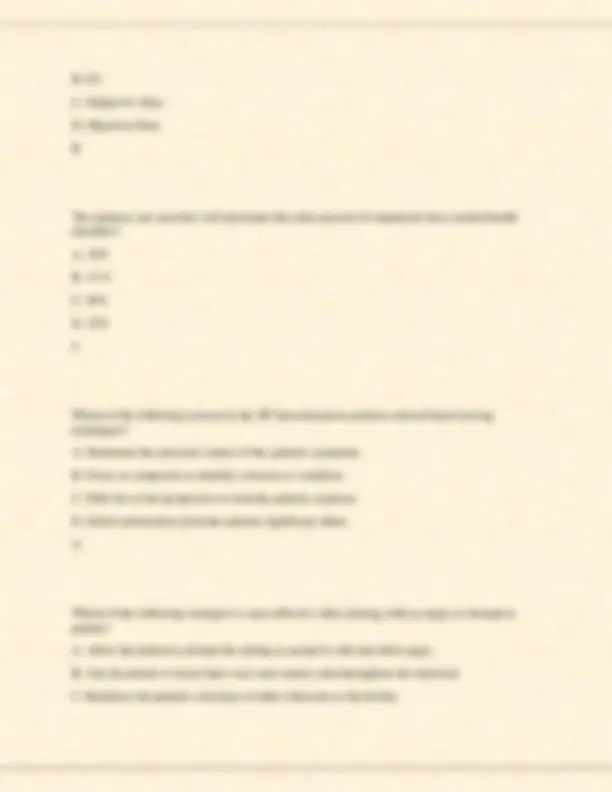
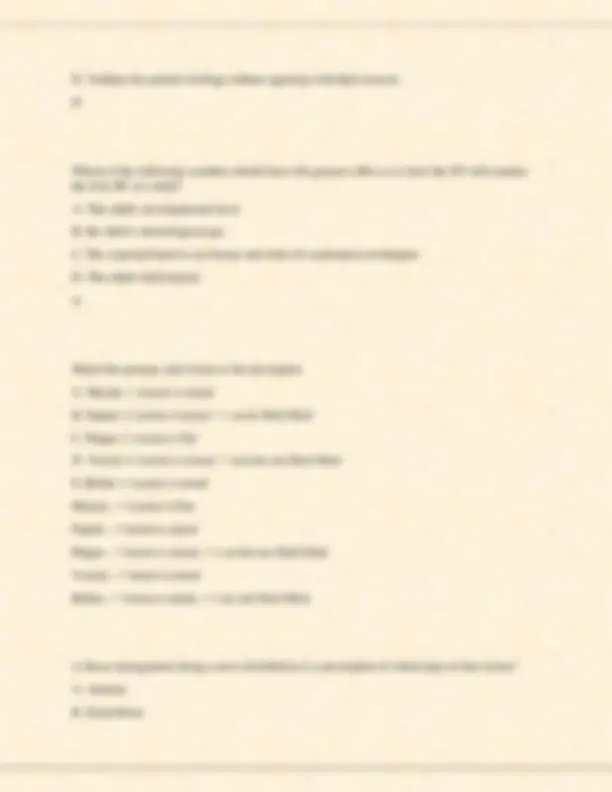
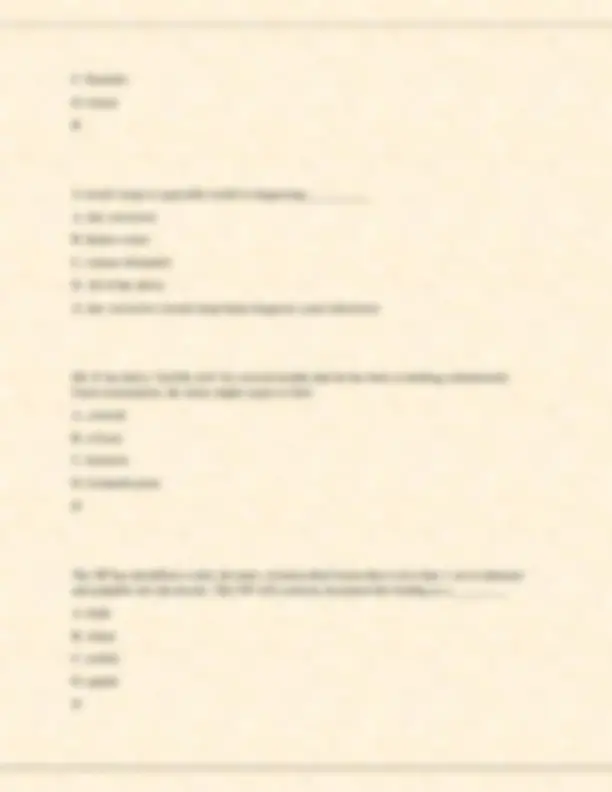
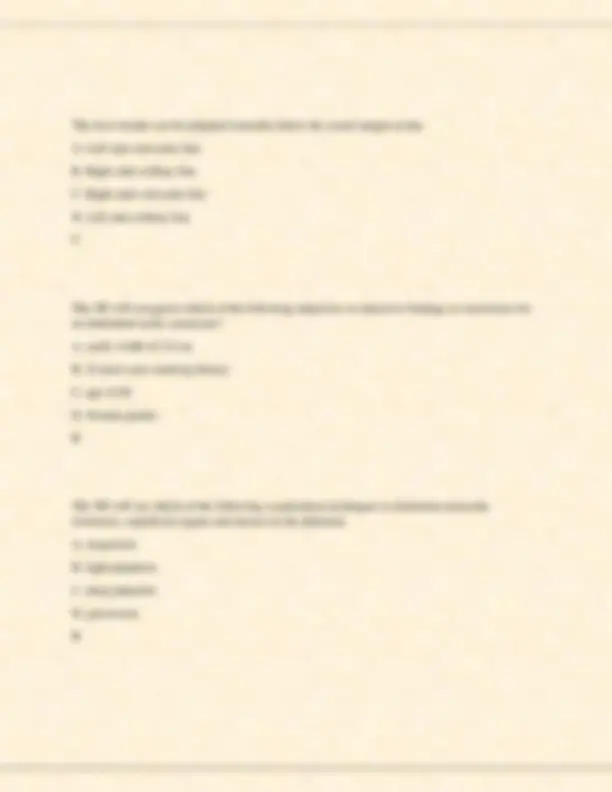
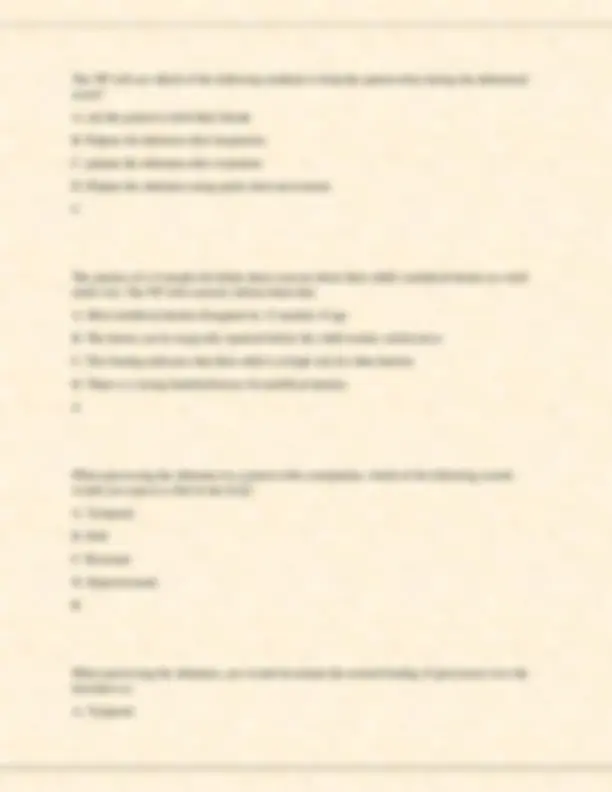
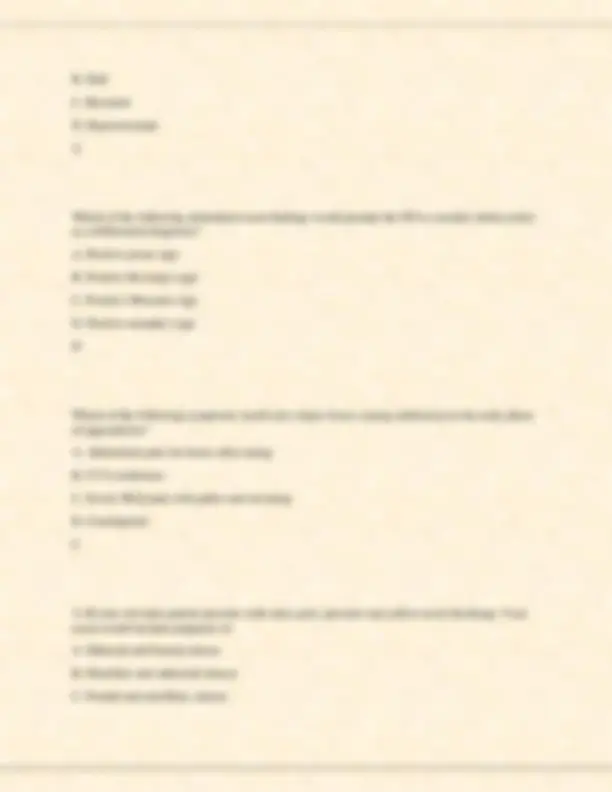
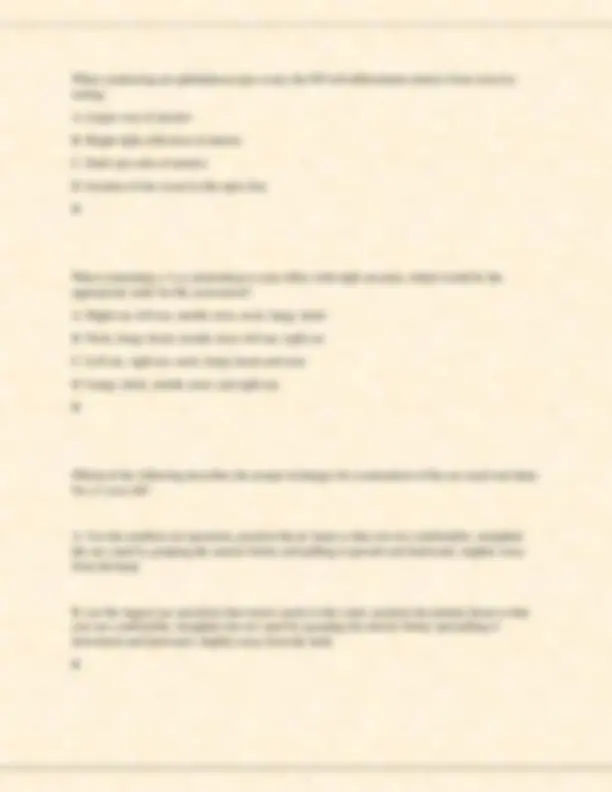
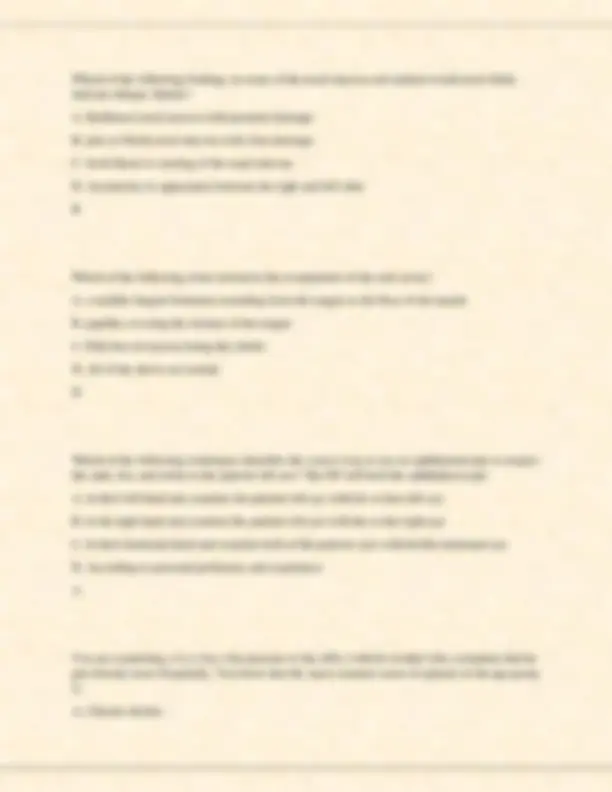
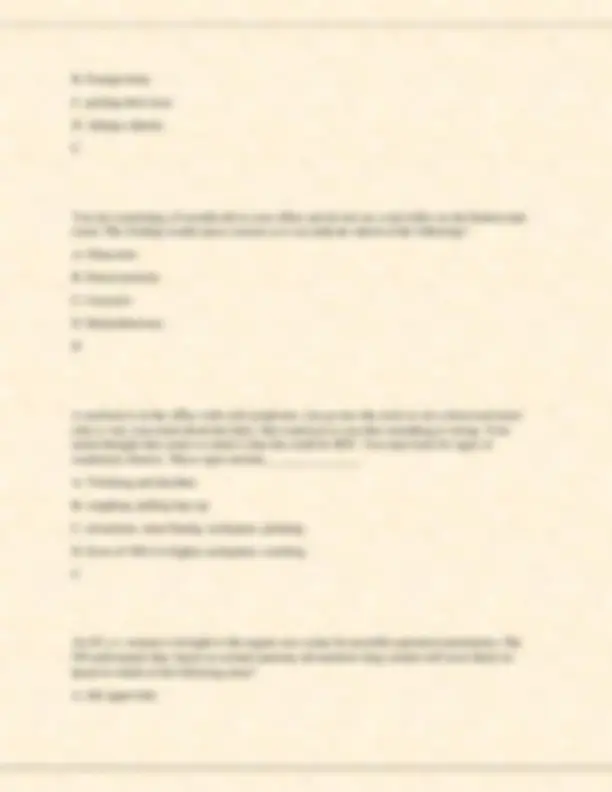
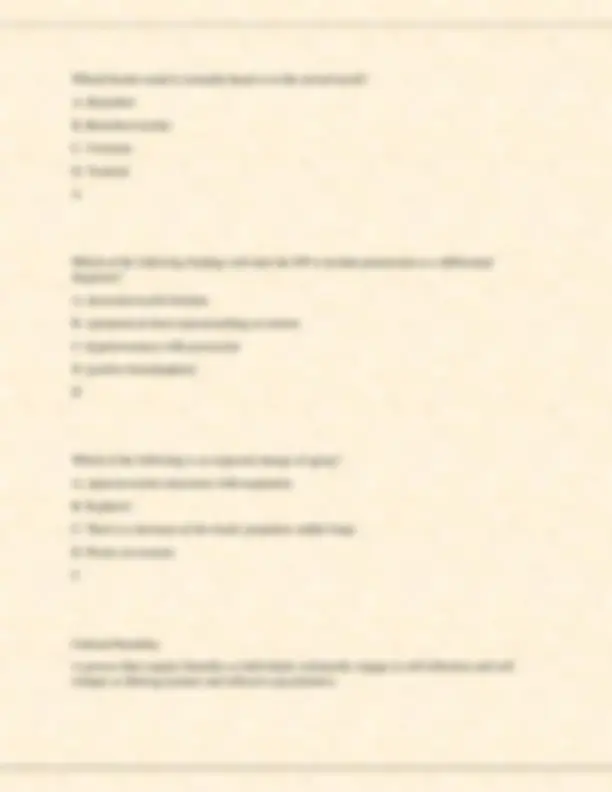
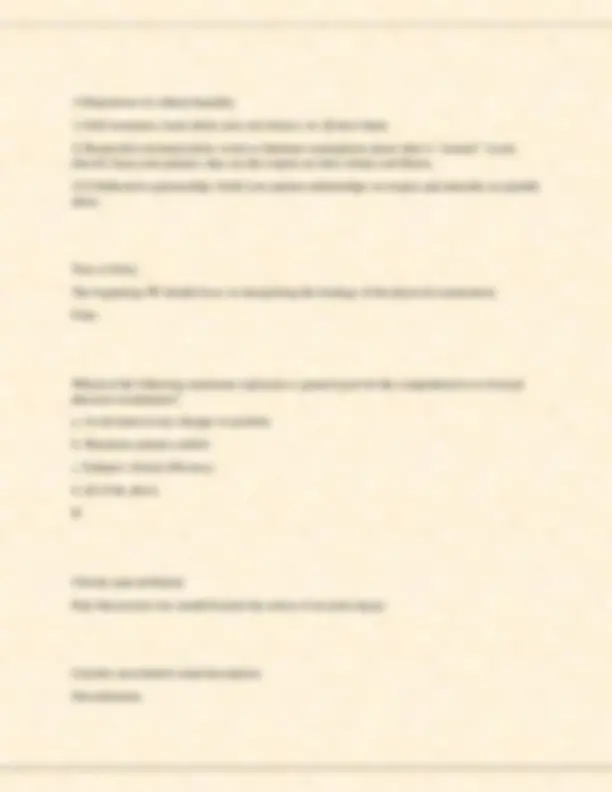
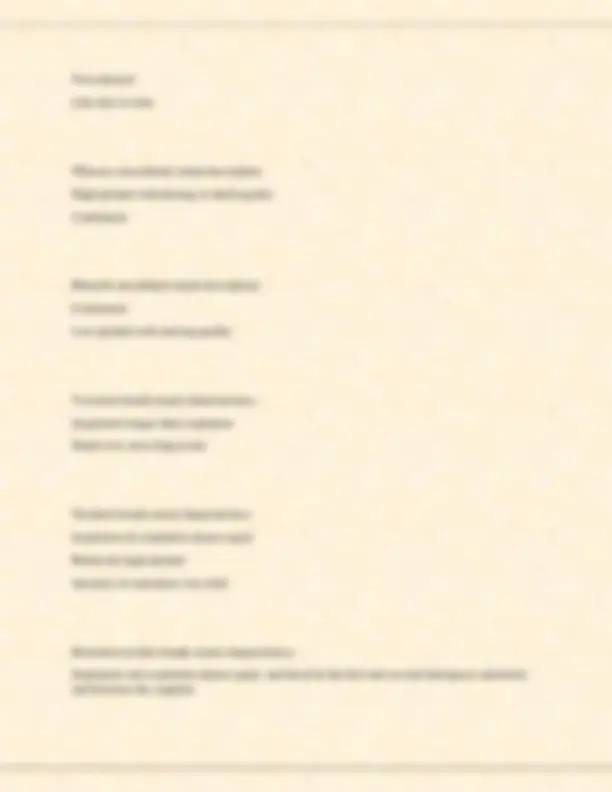
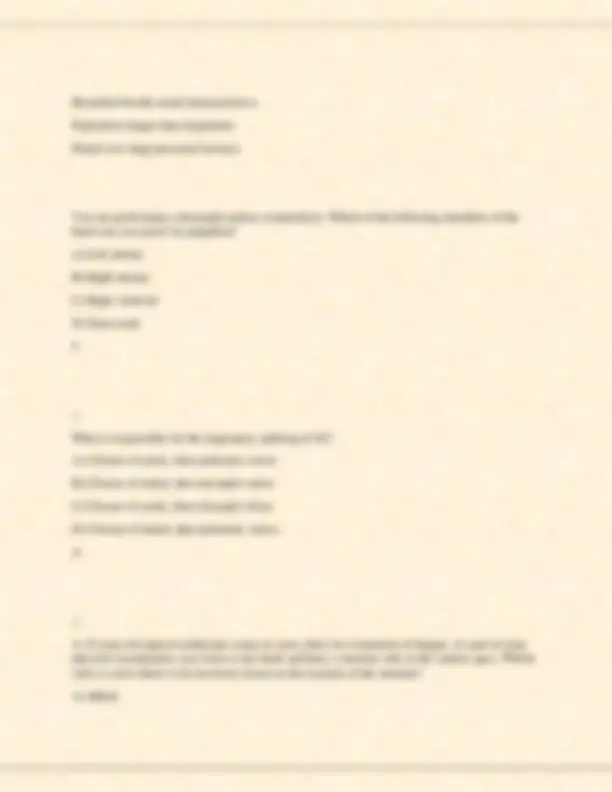
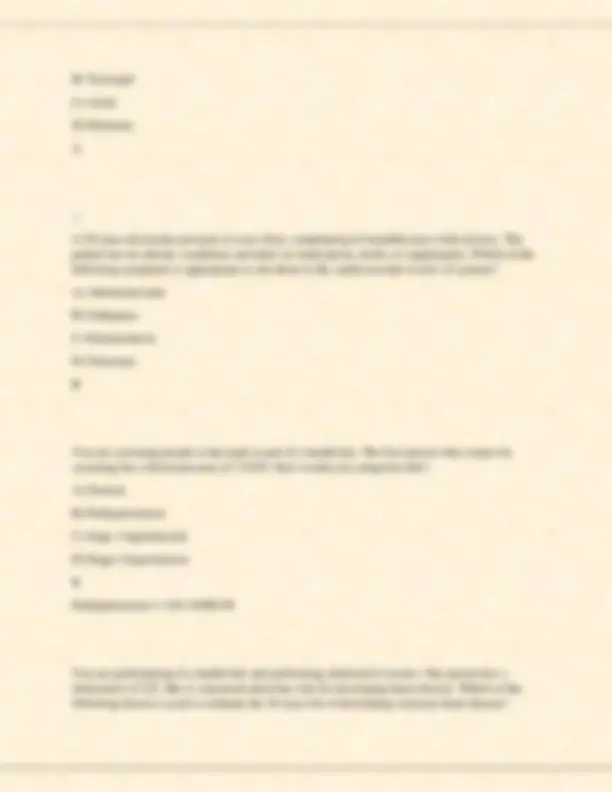
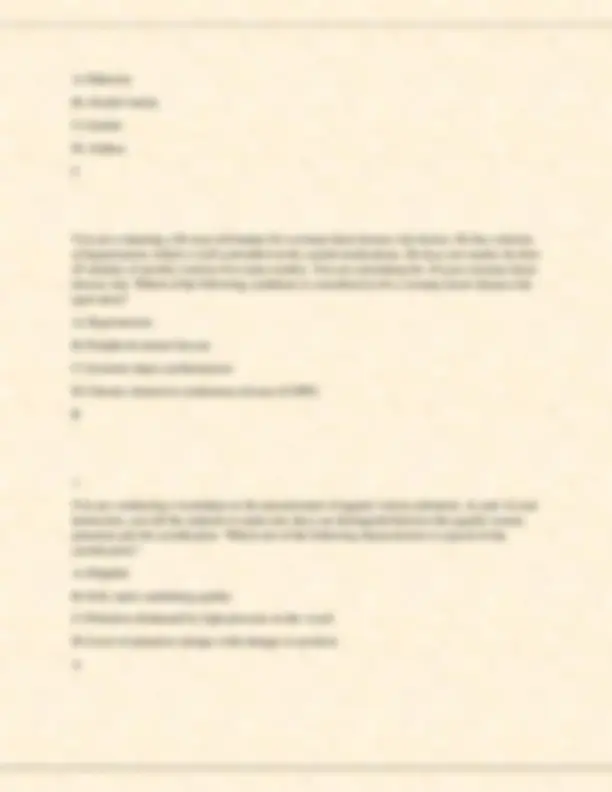
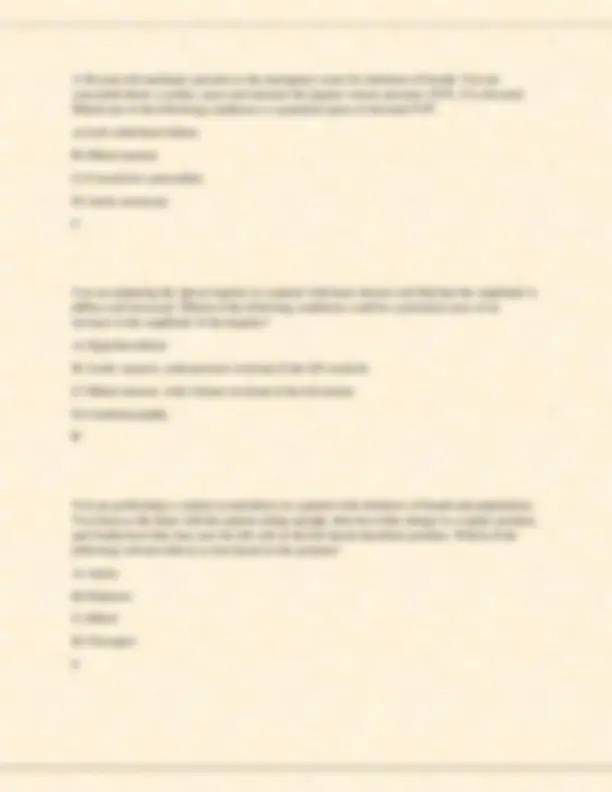
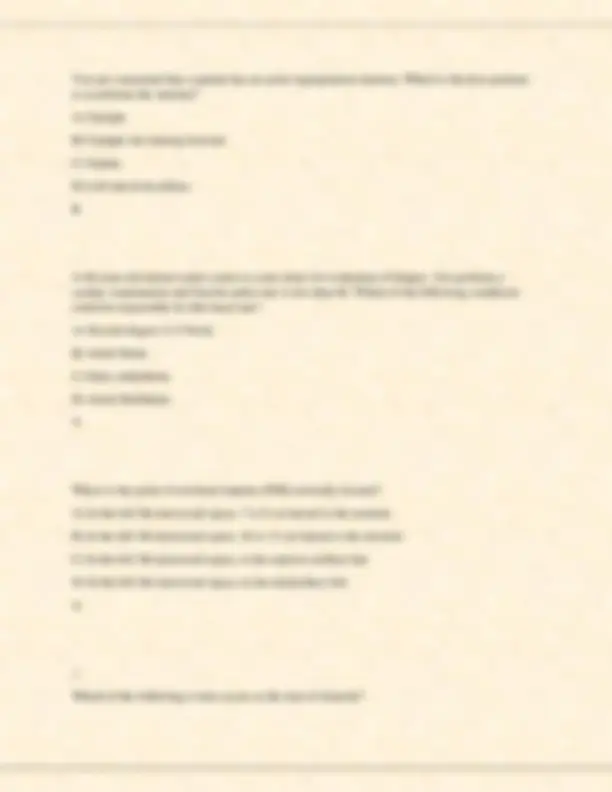
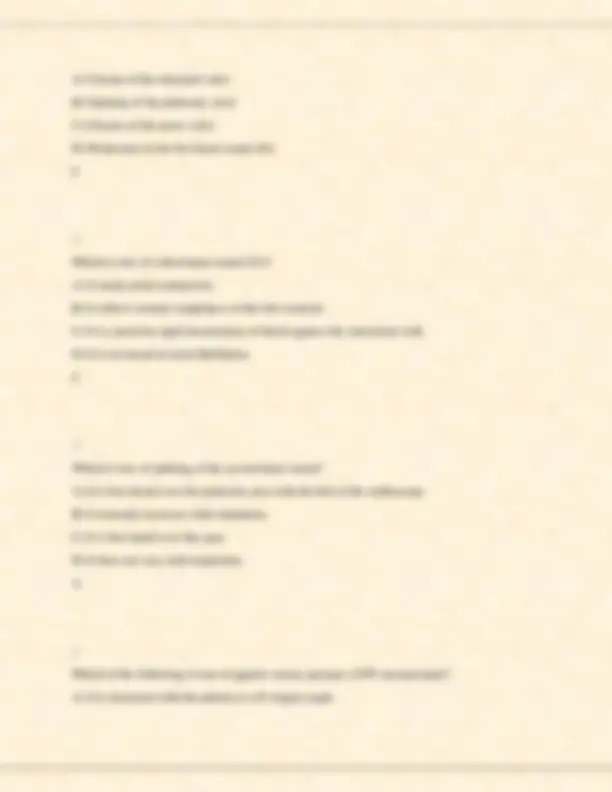
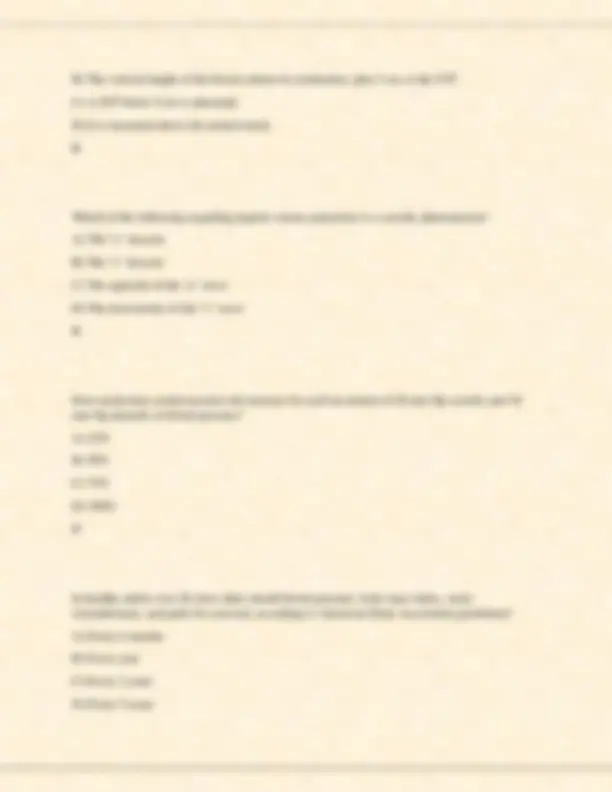
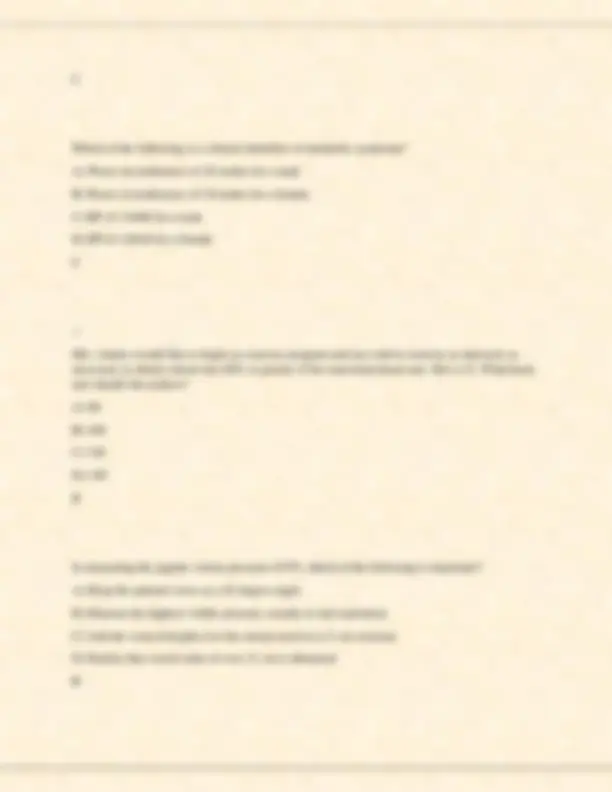
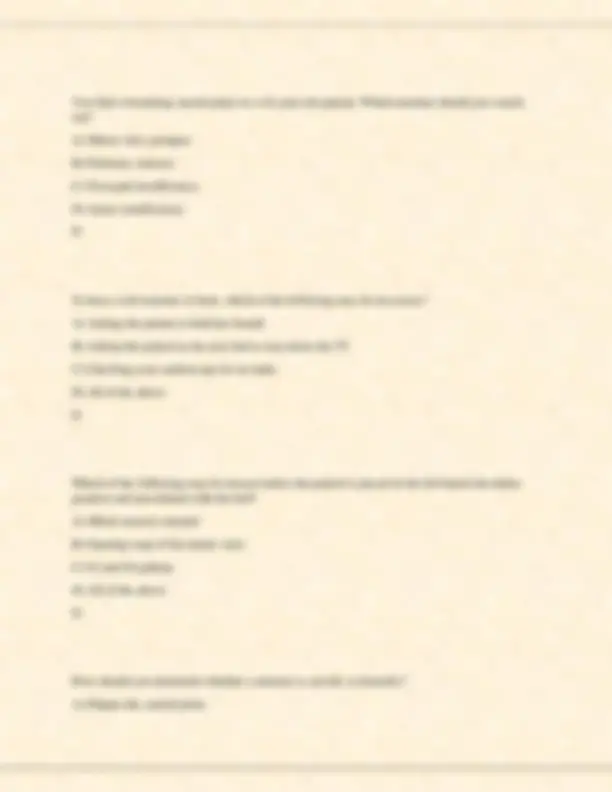
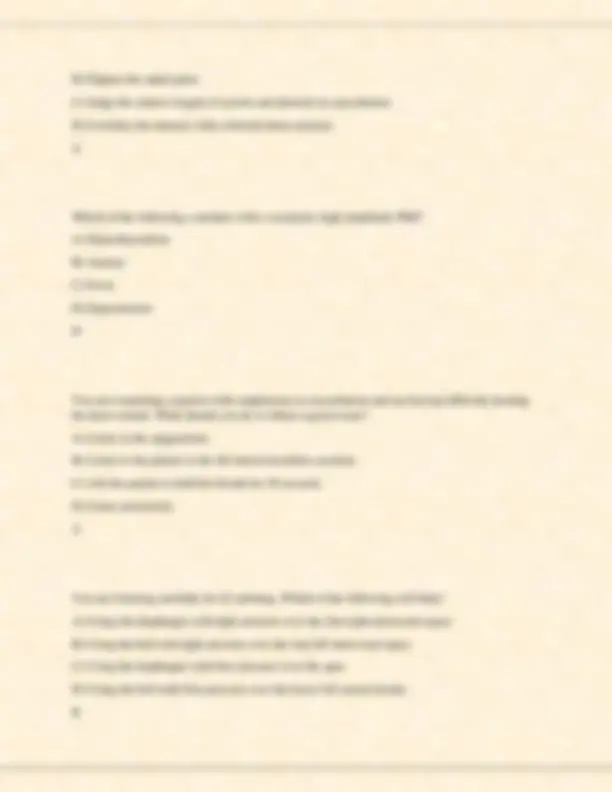
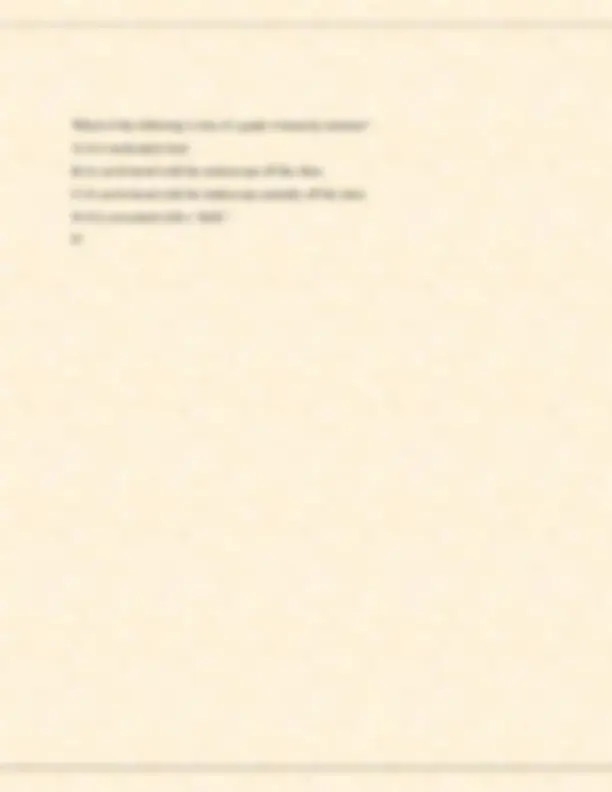


Study with the several resources on Docsity

Earn points by helping other students or get them with a premium plan


Prepare for your exams
Study with the several resources on Docsity

Earn points to download
Earn points by helping other students or get them with a premium plan
Community
Ask the community for help and clear up your study doubts
Discover the best universities in your country according to Docsity users
Free resources
Download our free guides on studying techniques, anxiety management strategies, and thesis advice from Docsity tutors
Midterm Exam: NU 650/ NU650 Health Assessment (Latest 2025/ 2026 Update) | Questions and Verified Answers | GRADED A | 100% Correct – Regis
Typology: Exams
1 / 31

This page cannot be seen from the preview
Don't miss anything!
























A patient is seen in the office for amenorrhea, for which you obtain a urine pregnancy test in the office that returns negative. You would document this finding in which of the following sections of the encounter? A. HPI B. CC C. Subjective Data D. Objective Data D: Objective data A patient you are seeing for the first time in your office, brings their previous medical records for the review. you would document a summer of the previous medical records in which of the following sections of the encounter note? A. HPI B. CC C. Subjective Data D. Objective Data C: Subjective data
The most effective process to elicit the ROS is for the NP to: A. Limit the ROS to systems related to the CC B. Follow the patients lead regarding the order of symptoms C. incorporate the ROS during the physical exam, stopping to make notes as necessary D. Start with general questions on each of the different body systems D The NP can determine higher cognitive function by asking the patient to perform which of the following tasks? A. Explain the meaning of a proverb B. Identify the day of the week, month, season, date and year C. Recall details of historical events D. Spell a five-letter word such as WORLD backward A The NP will ask the patient which of the following questions to assess for depression? A. have you ever been annoyed by other criticizing your alcohol use? B. Over the past two weeks have you felt little interest or pleasure in doing things? C. Over the past two weeks have you been unable to stop or control worrying? D. How often do you have contact with those that you care about or care about you? B The NP will document the reason for visit in which of the following sections of the encounter? A. HPI
D. Validate the patients feelings without agreeing with their reasons. D Which of the following variables should have the greatest affect as to how the NP will conduct the H & PE of a child? A. The child's developmental level B. the child's chronological age C. The expected head to toe format and order of examination techniques D. The child's birth history A Match the primary skin lesion to the description A. Macule 1. Lesion is raised B. Papule 2. Lesion is raised > 1 cm & fluid filled C. Plaque 3. Lesion is flat D. Vesicle 4. Lesion is raised, > 1cm but not fluid filled E. Bullae 5. Lesion is raised Macule --> Lesion is Flat Papule --> lesion is raised Plaque --> lesion is raised, > 1 cm but not fluid filled Vesicle --> lesion is raised Bullae --> lesion is raised, > 1 cm and fluid filled A linear arrangement along a nerve distribution is a description of which type of skin lesion? A. Annular B. Zosteriform
C. Keratitis D. Linear B A wood's lamp is especially useful in diagnosing __________ A. tine versicolor B. herpes zoster C. contact dermatitis D. All of the above A. tine versicolor (woods lamp helps diagnosis yeast infections) Mr. P. has had a "terrible itch" for several months that he has been scratching continuously. Upon examination, the nurse might expect to find: A. a keloid B. a fissue C. keratosis D. Lichenification D The NP has identified a solid, elevated, circumscribed lesion that is less than 1 cm in diameter and palpable into the dermis. This NP will correctly document this finding as a _________ A. bulla B. wheal C. nodule D. papule D
A. Stand at the patient's left side and proceed in a systematic fashion. B. Stand at the patient's left side and assess any problem areas first C. Stand at the patient's right side and process in a systemic fashion D. Stand at the patient's right side and assess any problem areas first C The NP will demonstrate the correct order of examination for the abdomen by using examination techniques that follows:
The liver border can be palpated normally below the costal margin at the: A. Left mid-clavicular line B. Right mid-axillary line C. Right mid-calvicular line D. Left mid-axillary line C The NP will recognize which of the following subjective or objective findings as worrisome for an abdominal aortic aneurysm? A. aortic width of 2.8 cm B. 25 pack-year smoking history C. age of 60 D. Female gender B The NP will use which of the following examination techniques to determine muscular resistance, superficial organs and masses in the abdomen A. inspection B. light palpation C. deep palpation D. percussion B
B. Dull C. Resonant D. Hyperresonant A Which of the following abdominal exam findings would prompt the NP to consider cholecystitis as a differential diagnosis? A. Positive psoas sign B. Positive Rovsing's sign C. Positive Obturator sign D. Positive murphy's sign D Which of the following symptoms would you expect from a young adolescent in the early phase of appendicitis? A. Abdominal pain two hours after eating B. CVA tenderness C. Severe RLQ pain with pallor and sweating D. Constipation C A 40 year old male patient presents with sinus pain, pressure and yellow nasal discharge. Your exam would include palpation of: A. Ethmoid and frontal sinuses B. Maxillary and sphenoid sinuses C. Frontal and maxillary sinuses
D. Sphenoid and ethmoid sinuses C A 60 y.o presents with a 3-day history of left eye irritation. Which of the following findings should be recorded in the ROS? A. Patient denies eye pain or change in vision B. Vision is 20/20 by Snellen Chary C. Yellow crust is visible at the inner canthus of the left eye D. all of the above A During a physical exam of the throat, which of the following structures of the mouth/throat should rise when the patient says "aah"? A. Hard palate B. Soft palate C. Lingual frenulum D. Buccal mucosa B In conductive type hearing loss, you would expect: A. sound lateralizes to the good ear when the weber test is used B. sound lateralizes to the affected (bad) ear when the weber test is used C. The weber test remains unaltered with conductive type hearing loss and sound will be heard equally in both ears D. The weber test can cause discomfort in a patient with conductive type hearing loss and should not be used in this situation B
When conducting an ophthalmoscopic exam, the NP will differentiate arteries from veins by noting: A. Larger size of arteries B. Bright light reflection of arteries C. Dark red color of arteries D. location of the vessel to the optic disc B When examining a 3 y.o presenting to your office with right ear pain, which would be the appropriate order for the assessment? A. Right ear, left ear, mouth, nose, neck, lungs, heart B. Neck, lungs, heart, mouth, nose, left ear, right ear C. Left ear, right ear, neck, lungs, heart and nose D. Lungs, heart, mouth, nose, and right ear. B Which of the following describes the proper technique for examination of the ear canal and drum for a 5 year old? A. Use the smallest ear speculum, position the pt. head so that you see comfortable, straighten the ear canal by grasping the auricle firmly and pulling it upward and backward, slightly away from the head. B. use the largest ear speculum that inserts easily in the canal, position the patients head so that you see comfortable, straighten the ear canal by grasping the auricle firmly and pulling it downward and backward, slightly away from the head B
Which of the following findings on exam of the nasal mucosa and septum would most likely indicate allergic rhinitis? A. Reddened nasal mucosa with purulent drainage B. pale or bluish nasal mucosa with clear drainage C. fresh blood or crusting of the nasal mucosa D. Asymmetry in appearance between the right and left sides B Which of the following is/are normal in the examination of the oral cavity? A. a midline lingual frenulum extending from the tongue to the floor of the mouth B. papillae covering the dorsum of the tongue C. Pink buccal mucosa lining the cheeks D. All of the above are normal D Which of the following techniques identifies the correct way to use an ophthalmascope to inspect the optic disc and retina in the patients left eye? The NP will hold the ophthalmoscope: A. in their left hand and examine the patients left eye with his or hear left eye B. in the right hand and examine the patients left eye with her or her right eye. C. In their dominant hand and examine both of the patients eyes with his/her dominant eye D. According to personal preference and experience A You are examining a 4 y.o boy who presents to the office with his mother who complains that he gets bloody noses frequently. You know that the most common cause of epitaxis in the age group is: A. Chronic rhinitis
B. left middle & lower lobes C. right upper lobe D. Right middle and lower lobes D Barrel chest is an abnormal chest configuration that may occur in which of the following disorders? A. COPD B. Pneumonia C. Pneumothorax D. TBA A Bronchovesticular sounds are heard normally at which location? A. second intercostal space anteriorly bilaterally B. base of lungs bilaterally, posteriorly C. laterally at the midaxillary line, bilaterally D. Bilaterally at the mid-clabicular line, 5th intercostal space A Normally when the lung fields are percussed the resulting sound is described as _______: A. hyperresonant B. resonant C. tympanic D. Dull B
The clinic has extended hours to provide flu vaccines and preventative teaching for the community. Based on current CDC influenza vaccine recommendations, the NP understands which of the following patients has a contraindication and cannot receive the vaccine? A. healthy 2 month baby girl B. primagravida at 32 weeks C. 60 y.o male with hx CHF D. 45 y.o female with BMI of 42 A The NP will nose a history of chronic cough based on the patients report of symptoms lasting for: A. 1 week B. 4 weeks C. 6 weeks D. 10 weeks D When compared to wheezes and rhonchi, the NP notes that on auscultation, crackles are: A. musical in quality B. prolonged sounds, typically persisting throughout the respiratory cycle C. intermittent and discontinuous sounds D. Relatively low-pitched with a snoring quality C
3 Dimensions of cultural humility
Non-musical Like dots in time Wheezes auscultated sound description: High pitched with hissing or shrill quality Continuous Rhonchi auscultated sound description: Continuous Low pitched with snoring quality Vesicular breath sound characteristics: Inspiration longer than expiration Heard over most lung tissue Tracheal breath sound characteristics: Inspiration & expiration almost equal Relatively high pitched Intensity of expiration very loud Bronchovesicular breath sound characteristics: Inspiration and expiration almost equal, and heard in the first and second interspaces anteriorly and between the scapulae